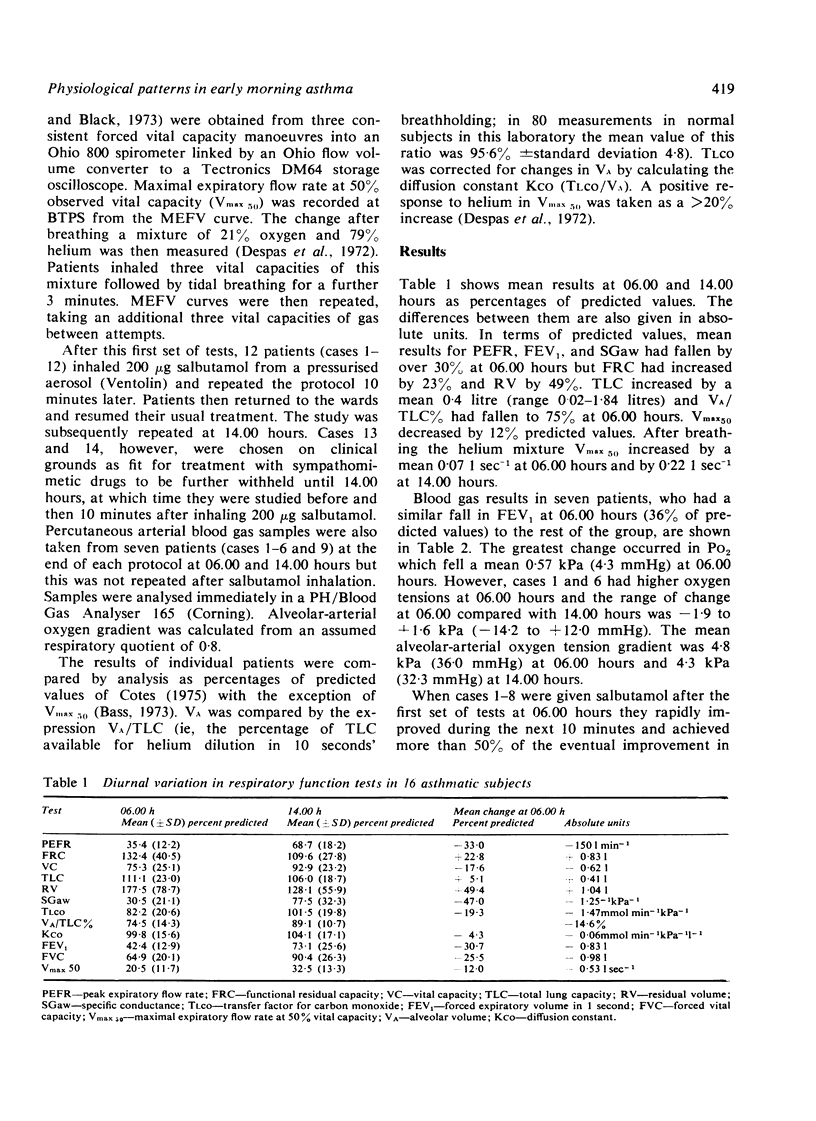Abstract
Sixteen asthmatic patients who regularly showed early morning falls in peak expiratory flow rate of more than 25% were studied at 06.00 hours and 14.00 hours. At 06.00 hours considerable deterioration in static lung volumes and airways resistance occurred which was typical of an attack of acute asthma. Blood gas analysis showed less variation, with mild hypoxia and a wide alveolar-arterial oxygen tension gradient throughout the study. Diurnal variation was also seen in the response of maximal mid expiratory flow rates to the inhalation of helium/oxygen mixture in seven patients, but another seven were consistently non-responders. The overall pattern of results suggests that the calibre of both large and small airways decreased at night but improvement was more complete in large airways during the day. Despite these findings patients had few symptoms at 06.00 hours when most of them showed marked reversibility after inhaling aerosol salbutamol. This phenomenon might account for the sudden nature of some asthma deaths as these often occur in the early morning. If this is the case, the minority of patients whose early morning decline in lung function was not immediately reversible would appear to be at greatest risk.
Full text
PDF





Images in this article
Selected References
These references are in PubMed. This may not be the complete list of references from this article.
- BLAKEMORE W. S., FORSTER R. E., MORTON J. W., OGILVIE C. M. A standardized breath holding technique for the clinical measurement of the diffusing capacity of the lung for carbon monoxide. J Clin Invest. 1957 Jan;36(1 Pt 1):1–17. doi: 10.1172/JCI103402. [DOI] [PMC free article] [PubMed] [Google Scholar]
- Bass H. The flow volume loop: normal standards and abnormalities in chronic obstructive pulmonary disease. Chest. 1973 Feb;63(2):171–176. doi: 10.1378/chest.63.2.171. [DOI] [PubMed] [Google Scholar]
- Benatar S. R., Clark T. J., Cochrane G. M. Clinical relevance of the flow rate response to low density gas breathing in asthmatics. Am Rev Respir Dis. 1975 Feb;111(2):126–134. doi: 10.1164/arrd.1975.111.2.126. [DOI] [PubMed] [Google Scholar]
- Bouhuys A., Van de Woestijne K. P. Respiratory mechanics and dust exposure in byssinosis. J Clin Invest. 1970 Jan;49(1):106–118. doi: 10.1172/JCI106209. [DOI] [PMC free article] [PubMed] [Google Scholar]
- Chan-Yeung M., Abboud R., Tsao M. S., Maclean L. Effect of helium on maximal expiratory flow in patients with asthma before and during induced bronchoconstriction. Am Rev Respir Dis. 1976 Apr;113(4):433–443. doi: 10.1164/arrd.1976.113.4.433. [DOI] [PubMed] [Google Scholar]
- Cochrane G. M., Clark J. H. A survey of asthma mortality in patients between ages 35 and 64 in the Greater London hospitals in 1971. Thorax. 1975 Jun;30(3):300–305. doi: 10.1136/thx.30.3.300. [DOI] [PMC free article] [PubMed] [Google Scholar]
- DUBOIS A. B., BOTELHO S. Y., BEDELL G. N., MARSHALL R., COMROE J. H., Jr A rapid plethysmographic method for measuring thoracic gas volume: a comparison with a nitrogen washout method for measuring functional residual capacity in normal subjects. J Clin Invest. 1956 Mar;35(3):322–326. doi: 10.1172/JCI103281. [DOI] [PMC free article] [PubMed] [Google Scholar]
- Despas P. J., Leroux M., Macklem P. T. Site of airway obstruction in asthma as determined by measuring maximal expiratory flow breathing air and a helium-oxygen mixture. J Clin Invest. 1972 Dec;51(12):3235–3243. doi: 10.1172/JCI107150. [DOI] [PMC free article] [PubMed] [Google Scholar]
- HYATT R. E., SCHILDER D. P., FRY D. L. Relationship between maximum expiratory flow and degree of lung inflation. J Appl Physiol. 1958 Nov;13(3):331–336. doi: 10.1152/jappl.1958.13.3.331. [DOI] [PubMed] [Google Scholar]
- Hutcheon M., Griffin P., Levison H., Zamel N. Volume of isoflow. A new test in detection of mild abnormalities of lung mechanics. Am Rev Respir Dis. 1974 Oct;110(4):458–465. doi: 10.1164/arrd.1974.110.4.458. [DOI] [PubMed] [Google Scholar]
- Hyatt R. E., Black L. F. The flow-volume curve. A current perspective. Am Rev Respir Dis. 1973 Feb;107(2):191–199. doi: 10.1164/arrd.1973.107.2.191. [DOI] [PubMed] [Google Scholar]
- Ingram R. H., Jr, Schilder D. P. Effect of thoracic gas compression on the flow-volume curve of the forced vital capacity. Am Rev Respir Dis. 1966 Jul;94(1):56–63. doi: 10.1164/arrd.1966.94.1.56. [DOI] [PubMed] [Google Scholar]
- Macdonald J. B., Seaton A., Williams D. A. Asthma deaths in Cardiff 1963-74: 90 deaths outside hospital. Br Med J. 1976 Jun 19;1(6024):1493–1495. doi: 10.1136/bmj.1.6024.1493. [DOI] [PMC free article] [PubMed] [Google Scholar]
- McDermott M. Diurnal and weekly cyclical changes in lung airways resistance. J Physiol. 1966 Oct;186(2):90P–92P. [PubMed] [Google Scholar]
- McFadden E. R., Jr, Linden D. A. A reduction in maximum mid-expiratory flow rate. A spirographic manifestation of small airway disease. Am J Med. 1972 Jun;52(6):725–737. doi: 10.1016/0002-9343(72)90078-2. [DOI] [PubMed] [Google Scholar]
- Mead J., Turner J. M., Macklem P. T., Little J. B. Significance of the relationship between lung recoil and maximum expiratory flow. J Appl Physiol. 1967 Jan;22(1):95–108. doi: 10.1152/jappl.1967.22.1.95. [DOI] [PubMed] [Google Scholar]
- Peress L., Sybrecht G., Macklem P. T. The mechanism of increase in total lung capacity during acute asthma. Am J Med. 1976 Aug;61(2):165–169. doi: 10.1016/0002-9343(76)90165-0. [DOI] [PubMed] [Google Scholar]
- Rees H. A., Millar J. S., Donald K. W. A study of the clinical course and arterial blood gas tensions of patients in status asthmaticus. Q J Med. 1968 Oct;37(148):541–561. [PubMed] [Google Scholar]
- Reinberg A., Gervais P. Circadian rhythms in respiratory functions, with special reference to human chronophysiology and chronopharmacology. Bull Physiopathol Respir (Nancy) 1972 May-Jun;8(3):663–677. [PubMed] [Google Scholar]
- Soutar C. A., Costello J., Ijaduola O., Turner-Warwick M. Nocturnal and morning asthma. Relationship to plasma corticosteroids and response to cortisol infusion. Thorax. 1975 Aug;30(4):436–440. doi: 10.1136/thx.30.4.436. [DOI] [PMC free article] [PubMed] [Google Scholar]
- Woolcock A. J., Read J. Lung volumes in exacerbations of asthma. Am J Med. 1966 Aug;41(2):259–273. doi: 10.1016/0002-9343(66)90021-0. [DOI] [PubMed] [Google Scholar]



